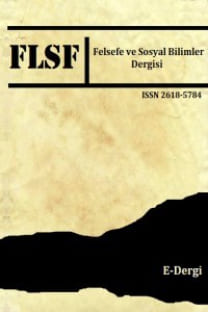AŞKINSAL İDEALİZM DOKTRİNİNİN AŞKINSAL ESTETİK BÖLÜMÜNDE GEREKÇELENDİRİLMESİ ÜZERİNE BİR TARTIŞMA
Kant, Aşkınsal İdealizm, Aşkınsal Estetik, mekan, apriori, sezgi, öznel form
A DISCUSSION CONCERNING THE JUSTIFICATION OF THE TRANSCENDENTAL IDEALISM DOCTRINE IN THE TRANSCENDENTAL AESTHETICS SECTION
Kant, Transcendental Idealism, Transcendental Aesthetics, space, a priori, intuition, subjective form.,
___
- Allison, H. E. (1983) Kant’s Transcendental Idealism: An Interpretation and Defence. New Haven: Yale University Press.
- Bird, Graham (1982) “Kant’s Transcendental Idealism,” Idealism Past and Present içinde, ed. Godfrey Vesey, 71-93. Cambridge: Cambridge University Press.
- Dallas,Wilson, Kirk. “Kant on Intuition,” The Philosophical Quarterly, Vol 25 (1975): 247-265.
- Dryer, D. P. Kant’s Solution for Verification in Metaphysics. Sydney: Allen & Unwin.
- Falkenstein, Lorne. (2004) Kant’s Intuitionism: A Commentry on Transcendental Aesthetic. Toronto: Toronto University Pres.
- Guyer, P. (1987) Kant and the Claims of Knowldge. Cambridge: Cambridge University Press.
- Hatfield, Gary. (2007) “Kant on the perception of space (and time),” The Cambridge Companion to Kant and Modern Philosophy içinde, ed. Paul Guyer, 61-94. Cambridge: Cambridge University Press.
- Kant, Immanuel. (1965) Critique of Pure Reason, çev. Norman Kemp Smith. New York: St Martin’s Press.
- Kant, Immanuel. (1992) Lectures on Logic, çev. J. Michael Young. Cambridge: Cambridge University Press.
- Parsons, Charles. (1992) “The Transcendental Aesthetic,” Cambridge Compainion to Kant içinde, ed. Paul Guyer, 62-101. Cambridge: University Press.
- Paton, H. J. (1936) Kant’s Metaphysics of Experience. Londra: Allen & Unwin.
- Prichard, H. A. (1909) Kant’s Theory of Knowledge. Oxford: Clarendon Pres.
- Shabel, Lisa. (2010) “The Transcendental Aesthetic,” The Cambridge Companion to Kant’s Critique of Pure Reason içinde, ed. Paul Guyer, 93-118. Cambridge: University Press.
- Smith, N. K. (2003) A Commentary to ‘Kant’s Critique Of Pure Reason.’ New York: Palgrave Macmillan.
- Strawson, P. F. (1966) The Bounds of Sense: An Essay on Kant’s Critique of Pure Reason, London: Routledge.
- Yayın Aralığı: Yılda 2 Sayı
- Başlangıç: 2006
- Yayıncı: Hamdi BRAVO
HAKİKATİ KEŞFETMENİN YOLU OLARAK YÖNTEMLİ DÜŞÜNME
MODERNİTE VE TİRANLIK: LEO STRAUSS’UN MODERNİTE ELEŞTİRİSİNDE TİRANLIK BOYUTU
WHY ALEXIS DE TOCQUEVILLE IS NOT A REPUBLICAN BUT A LIBERAL
MARX’DA KAPİTALİST DEVLET BAĞLAMINDA YÖNETENLER VE YABANCILAŞMA SORUNU
WITTGENSTEIN’IN PSİKOLOJİ FELSEFESİ BAĞLAMINDA DENEYİM VE İFADE İLİŞKİSİ
İNSANIN KENDİSİNİ GERÇEKLEŞTİRMESİNDE ADALET KAVRAMI
AYLAKLIK, ZAMANSALLIK VE YAŞLILIK
SAVAŞ PROPAGANDASINDA UYGULANAN SEMANTİK ŞİDDET ÜZERİNE
DİE WELTBÜHNE DERGİSİNİN NAZİZM’E KARŞI VERDİĞİ ENTELEKTÜEL MÜCADELE
F.C.S. SCHILLER’İN PRAGMATİK HÜMANİZMİNDE FELSEFİ VE BİLİMSEL METOTLARA DAİR ELEŞTİREL BİR YAKLAŞIM
